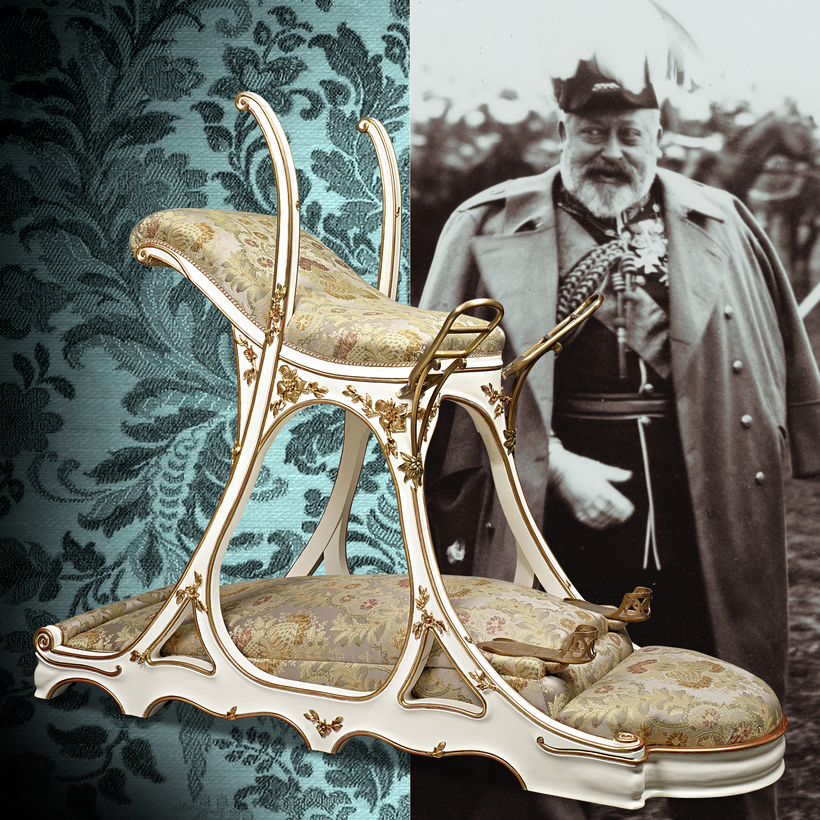The great Parisian love chair on sale in a New Orleans antique shop is a remarkable combination of artistry and debauchery; a symbol of ingenious Anglo-French co-operation and a reminder of an age when Paris managed to be seedy, glamorous and creative all at the same time. The replica of the siège d’amour from the Paris brothel Le Chabanais, built in 1890 by the cabinet maker Louis Soubrier, enabled the user to have sex with two women simultaneously while reclining in comfort on brocade upholstery. There are useful handles, footholds, and neo-rococo bronze stirrups.
It was not just used by the future Edward VII who was known as “Dirty Bertie” in his younger days; it was created for him. Because when Queen Victoria’s eldest son turned up in Paris looking for fun, he was already distinctly rotund, with a waist measurement well on the way to the 44 inches it would reach by the time of his coronation. The made-to-measure contraption was designed for Bertie’s bulk, enabling the portly prince to lie back and think of England without crushing the other participants.
Le Chabanais also provided the prince with a vast, swan-necked bath filled with champagne, large enough for two or more. When the bordello was eventually closed down and its contents sold at auction in 1951 Salvador Dalí bought the prince’s bath for his room at the Hotel Meurice.
Today Paris is going through one of its periodic bouts of puritanism, the latest twist in a long and contradictory French relationship with commercial sex. In 2016 the National Assembly voted to punish customers of sex workers with a fine of $1,620. The Quartier Pigalle, with its peep shows and sex shops, is not just unerotic and squalid but very dull.
The belle époque Paris that Prince Edward frequented was a riot of vice and imagination, cocottes and courtesans, painters and poets. It produced stunning art, and human misery and exploitation on a grand scale. For every high-class prostitute paid in diamonds or racehorses, such as Louise Valtesse de la Bigne who made a fortune equivalent to $2.6 million today, there were thousands of street walkers living wretched lives, forced to sell their bodies.
Napoleon made prostitution not only legal but regulated, with registration and health inspections. Buttoned-up Englishmen flocked to Paris in order to unbutton. A guide printed in 1883, Pretty Women of Paris, offered British sex tourists a pictorial directory of prostitutes, such as the celebrated Cora Pearl (born Eliza Emma Crouch, in Plymouth) who could be served up on an enormous plate, complete with parsley garnish.

For wealthy and virginal Grand Tourists a stop in Paris was de rigueur. Charles Dickens toured the Paris brothel scene with his friend, Wilkie Collins. “I want to throw myself en garçon on the festive diableries of Paris,” Dickens wrote. The sex industry catered to every taste. Marcel Proust invested in two gay brothels. In the latter half of the 19th century Paris contained 300 registered brothels. “This is where prostitution is on display,” wrote Flaubert after a visit to the red-light district. “This is where eyes shine.”
Le Chabanais, founded by the Irish-born Madame Kelly, was not just a place of licentiousness and luxury but beauty and elegance. Rooms were decorated in Moorish, Hindu and Roman styles. The Japanese room won a design prize at the World Fair in 1900.
In addition to the prince, the Parisian brothel was frequented by the likes of Henri de Toulouse-Lautrec, Cary Grant, Marlene Dietrich and the Maharaja of Kapurthala. Foreign heads of state visiting the Elysée would have time set aside in their diaries for a “meeting with the President of the Senate”, a euphemism for a visit to Le Chabanais. The author Guy de Maupassant recreated the Moorish room in his seaside home so that he could remember it on holiday.
More queasily, the bordello also catered to Wehrmacht officers during the Nazi occupation. Hermann Goering was a regular and 22 brothels were set aside for German use.
Behind the glitter of the demi-monde was another world, racked with poverty, alcoholism, sexual diseases and degradation. The artists and writers came to celebrate and romanticise but many, including Picasso, reflected and depicted the dark side of the sex industry.
At the other end of the social scale from chic establishments such as Le Chabanais were the maisons d’abattage (slaughterhouses), where clients lined up with numbered tickets and the prostitutes were treated like slot machines.
France has always oscillated between permissiveness and prudery, alternately enabling prostitution and trying to stop it. Louis XIV locked up women found guilty of “public debauchery”; the French Revolution decriminalised the industry but then banned prostitutes from walking the streets. In 1946 brothels were prohibited, in part because sex workers had been accused of collaboration horizontale, complicity with the Nazi occupiers. About 1,400 maisons de tolérance closed across France, including Le Chabanais. Since the passing of the 2016 law 400 people have been prosecuted but the legislation is merely pushing the trade from the street to hotels and apartments, via the internet.
We may imagine Paris as a citadel of sexual licence but the French are as confused and conflicted on the subject as we are. That ambivalence is symbolised by Prince Edward’s love chair. It is impossible not to admire the wit and artistry that went into its creation. But equally it is worth remembering the unnamed women paid to perform beneath the fat foreign prince. The chair is remembered. They are forgotten.

